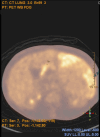A Rare Presentation of a Devastating Disease: Hepatosplenic T-Cell Lymphoma in Crohn's Disease Without Thiopurine Exposure
- PMID: 40343217
- PMCID: PMC12061462
- DOI: 10.14309/crj.0000000000001695
A Rare Presentation of a Devastating Disease: Hepatosplenic T-Cell Lymphoma in Crohn's Disease Without Thiopurine Exposure
Abstract
Hepatosplenic T-cell lymphoma (HSTCL) is a rare, aggressive malignancy that has been associated with thiopurines during the treatment of inflammatory bowel disease (IBD). We present a case of a 26-year-old man with Crohn's disease on infliximab without prior thiopurine exposure who developed HSTCL. His diagnosis was confirmed through flow cytometry, fluorescence in situ hybridization, and bone marrow biopsy. This is the sixth case of HSTCL in patients with IBD without prior thiopurine exposure and highlights the need for a comprehensive risk-benefit discussion with patients on the various treatment modalities for IBD.
Keywords: Crohn's; hepatosplenic T-cell lymphoma; inflammatory bowel disease; thiopurines; tumor necrosis factor alpha inhibitors, infliximab.
© 2025 The Author(s). Published by Wolters Kluwer Health, Inc. on behalf of The American College of Gastroenterology.
Figures


Similar articles
-
Hepatosplenic T-cell lymphoma in a 47-year-old Crohn's disease patient on thiopurine monotherapy.World J Gastroenterol. 2016 Dec 21;22(47):10465-10470. doi: 10.3748/wjg.v22.i47.10465. World J Gastroenterol. 2016. PMID: 28058028 Free PMC article.
-
Hepatosplenic T-cell lymphoma in a young man with Crohn's disease: case report and literature review.Clin Lymphoma Myeloma Leuk. 2010 Apr;10(2):144-8. doi: 10.3816/CLML.2010.n.021. Clin Lymphoma Myeloma Leuk. 2010. PMID: 20371449 Review.
-
Hepatosplenic T-Cell Lymphoma: A Rare Complication of Monotherapy with Thiopurines in Crohn's Disease.GE Port J Gastroenterol. 2019 Jul;26(4):279-284. doi: 10.1159/000493350. Epub 2018 Nov 28. GE Port J Gastroenterol. 2019. PMID: 31328143 Free PMC article.
-
Hepatosplenic T-cell lymphoma and inflammatory bowel disease.J Crohns Colitis. 2010 Nov;4(5):511-22. doi: 10.1016/j.crohns.2010.05.006. Epub 2010 Jun 25. J Crohns Colitis. 2010. PMID: 21122554 Review.
-
T-cell non-Hodgkin's lymphomas reported to the FDA AERS with tumor necrosis factor-alpha (TNF-α) inhibitors: results of the REFURBISH study.Am J Gastroenterol. 2013 Jan;108(1):99-105. doi: 10.1038/ajg.2012.334. Epub 2012 Oct 2. Am J Gastroenterol. 2013. PMID: 23032984
References
-
- Dassopoulos T, Sultan S, Falck-Ytter YT, Inadomi JM, Hanauer SB. American Gastroenterological Association Institute technical review on the use of thiopurines, methotrexate, and anti-TNF-α biologic drugs for the induction and maintenance of remission in inflammatory Crohn's disease. Gastroenterology. 2013;145(6):1464–78.e785. - PubMed
-
- Shah ED, Coburn ES, Nayyar A, Lee KJ, Koliani-Pace JL, Siegel CA. Systematic review: Hepatosplenic T-cell lymphoma on biologic therapy for inflammatory bowel disease, including data from the Food and Drug Administration Adverse Event Reporting System. Aliment Pharmacol Ther. 2020;51(5):527–33. - PMC - PubMed
Publication types
LinkOut - more resources
Full Text Sources

